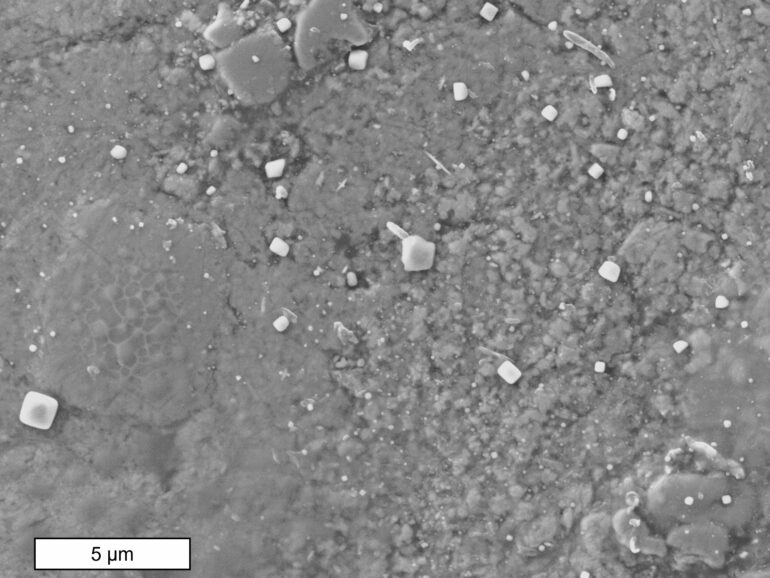New analysis of the Winchcombe meteorite has revealed just how quickly space rocks which fall to Earth can be contaminated by our atmosphere.
The meteorite, which landed in Gloucestershire in February last year, was the first to be recovered on UK soil in nearly 30 years.
Fragments were recovered from a domestic driveway hours after it entered the Earth’s atmosphere. More pieces were found in a sheep field six days after that.
The results show that despite the rapid recovery of the meteorites, the fragments quickly developed several ‘terrestrial phases’—salts and minerals which developed from the interaction of their surfaces with the damp environment in which they landed.
The findings could inform future efforts to protect new meteorites after they are found. They could also help geological missions to asteroids and other planets keep their samples free of terrestrial contaminants once they return to Earth.
The paper’s lead author is Laura Jenkins, a Ph.D. student at the University of Glasgow’s School of Geographical & Earth Sciences.
She said, “Analysis of meteorites can provide insights into the asteroids they come from and how they have formed. Winchcombe and other meteorites like it contain extra-terrestrial water and organics, and the asteroids they come with may be responsible for delivering water to Earth, giving it enough water to form its distinctive oceans.”
“However, when a meteorite is exposed to terrestrial contaminants, especially moisture and oxygen, it undergoes changes, affecting the information it provides.”
In a new paper published in the journal Meteoritics & Planetary Science, a University of Glasgow-led team of researchers how they examined two small pieces of Winchcombe for signs of terrestrial modifications.
They used scanning electron microscopy, Raman spectroscopy and transmission electron microscopy to scrutinize the surfaces of the samples. One sample was taken from the driveway fragments and the other from those found in the sheep field.
They found that two forms of salt—sulfates of calcium and calcite—had formed on the fusion crust of samples recovered from the sheep field. Meanwhile, they observed halite, also known as table salt, on the sample taken from the driveway.
The fusion crust is the distinctive material formed when meteorites melt during their fiery entry to the Earth’s atmosphere. The researchers conclude that, since the sulfates appeared on the outside of the fusion crust, it is likely that they appeared after it landed, as a result of exposure to damp conditions in the sheep field.
Meanwhile, the halite appeared only on the surface of polished sections of the driveway fragment. Since the polishing was done after the meteorite was recovered, it is likely that it was formed by the interaction of the rock slice with the humid laboratory air.
Jenkins added: “The Winchcombe meteorite is often described as a ‘pristine’ example of a CM chondrite meteorite, and it’s already yielded remarkable insights.”
“However, what we’ve shown with this study is that there’s really no such thing as pristine meteorite—terrestrial alteration begins the moment it encounters Earth’s atmosphere, and we can see it in these samples which we analyzed just a couple of months after the meteorite landed.
“It shows just how reactive meteorites are to our atmosphere, and how careful we need to be about ensuring that we take this kind of terrestrial alteration into account when we analyze meteorites.”
“To minimize terrestrial alteration, meteorites should be stored in inert conditions if possible.”
“Understanding which phases are extra-terrestrial and which are terrestrial in meteorites like Winchcombe will not only help our understanding of their formation but will also aid in relating meteorites that have landed on Earth to samples returned by sample return missions. A more complete picture of the asteroids in our solar system and their role in Earth’s development can be built.”
Dr. Luke Daly, a co-author on the paper, is a lecturer at the University of Glasgow and part of the UK Fireball Alliance, or UKFall, the observation network which spotted the Winchcombe meteorite and estimated where it landed. Dr. Daly led the search party that recovered the largest chunk of the Winchcombe meteorite from a sheep field, where it was spotted by volunteer Mira Ihasz.
He said, “We’ve always known that exposure to Earth’s atmosphere affects the surface of meteorites but this is the first time we’ve been able to see just how quickly the process can begin and advance.”
“We were very lucky to be able to recover the Winchcombe meteorite so quickly through the monitoring of the UKFall network and the efforts of the volunteers who helped us recover the largest pieces from the field.”
“This research shows just how vital it is that we keep watching the skies and assemble search parties as quickly as possible after meteorites are spotted.”
More information:
Laura E. Jenkins et al, Winchcombe: An example of rapid terrestrial alteration of a CM chondrite, Meteoritics & Planetary Science (2023). DOI: 10.1111/maps.13949
Provided by
University of Glasgow
Citation:
Earth’s atmosphere adds a quick pinch of salt to meteorites, scientists find (2023, February 10)
